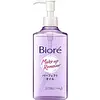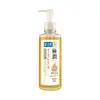What's inside
What's inside
 Key Ingredients
Key Ingredients

 Benefits
Benefits

No benefits
 Concerns
Concerns

 Ingredients Side-by-side
Ingredients Side-by-side

Paraffinum Liquidum
EmollientPEG-12
HumectantLauric Acid
CleansingIsododecane
EmollientIsopropyl Palmitate
EmollientWater
Skin ConditioningPolyglyceryl-2 Isostearate
EmulsifyingDecyl Glucoside
CleansingPolysorbate 85
EmulsifyingGlyceryl Oleate
EmollientIsostearic Acid
CleansingIsostearyl Glyceryl Ether
Skin ConditioningMyristyl Alcohol
EmollientIsostearyl Glyceryl Pentaerythrityl Ether
EmollientAlcohol Denat.
AntimicrobialCitric Acid
BufferingBHT
AntioxidantParfum
MaskingParaffinum Liquidum, PEG-12, Lauric Acid, Isododecane, Isopropyl Palmitate, Water, Polyglyceryl-2 Isostearate, Decyl Glucoside, Polysorbate 85, Glyceryl Oleate, Isostearic Acid, Isostearyl Glyceryl Ether, Myristyl Alcohol, Isostearyl Glyceryl Pentaerythrityl Ether, Alcohol Denat., Citric Acid, BHT, Parfum
Water
Skin ConditioningButylene Glycol
HumectantSodium Myristoyl Glutamate
CleansingSorbitol
HumectantSodium Methyl Cocoyl Taurate
CleansingSodium Lauroyl Glutamate
Cocamide DEA
EmulsifyingMyristic Acid
CleansingGlyceryl Stearate
EmollientSodium Chloride
MaskingLauric Acid
CleansingPEG-40 Hydrogenated Castor Oil
EmulsifyingPolyglyceryl-2 Isostearate
EmulsifyingPolyquaternium-7
Methylparaben
PreservativeSodium Acetylated Hyaluronate
HumectantHydroxypropyltrimonium Hyaluronate
Water, Butylene Glycol, Sodium Myristoyl Glutamate, Sorbitol, Sodium Methyl Cocoyl Taurate, Sodium Lauroyl Glutamate, Cocamide DEA, Myristic Acid, Glyceryl Stearate, Sodium Chloride, Lauric Acid, PEG-40 Hydrogenated Castor Oil, Polyglyceryl-2 Isostearate, Polyquaternium-7, Methylparaben, Sodium Acetylated Hyaluronate, Hydroxypropyltrimonium Hyaluronate
 Reviews
Reviews

Alternatives
Ingredients Explained
These ingredients are found in both products.
Ingredients higher up in an ingredient list are typically present in a larger amount.
Lauric Acid is a fatty acid or lipid. About half of fatty acids in coconut oil is lauric acid.
This ingredient helps hydrate and sooth skin. As a humectant, it helps trap moisture. It also aids in cleaning and enhancing the texture of products.
Lauric acid may not be Malassezia folliculitis, or fungal acne, safe.
Learn more about Lauric AcidPolyglyceryl-2 Isostearate isn't fungal acne safe.
Water. It's the most common cosmetic ingredient of all. You'll usually see it at the top of ingredient lists, meaning that it makes up the largest part of the product.
So why is it so popular? Water most often acts as a solvent - this means that it helps dissolve other ingredients into the formulation.
You'll also recognize water as that liquid we all need to stay alive. If you see this, drink a glass of water. Stay hydrated!
Learn more about Water